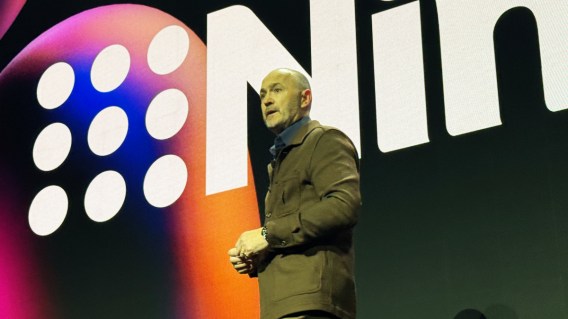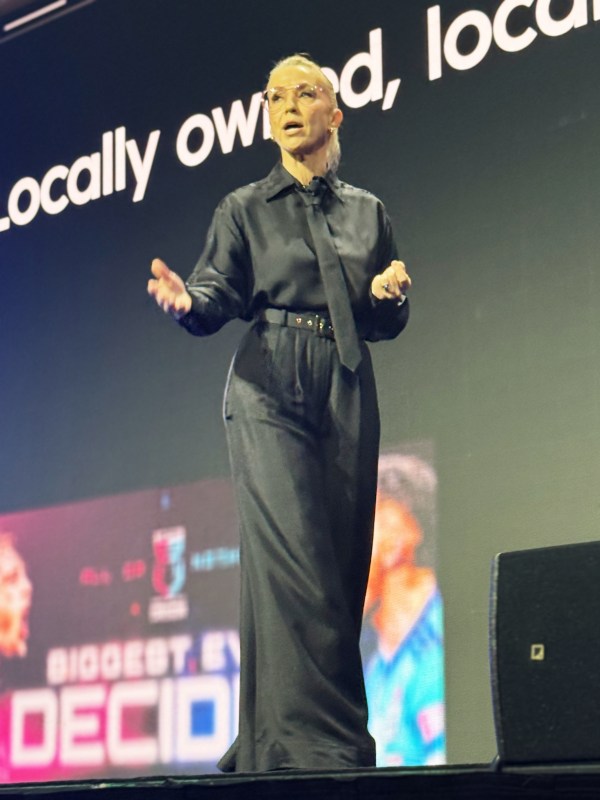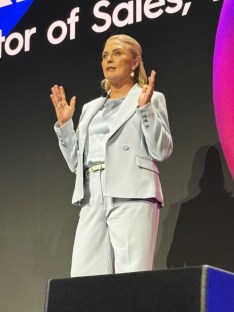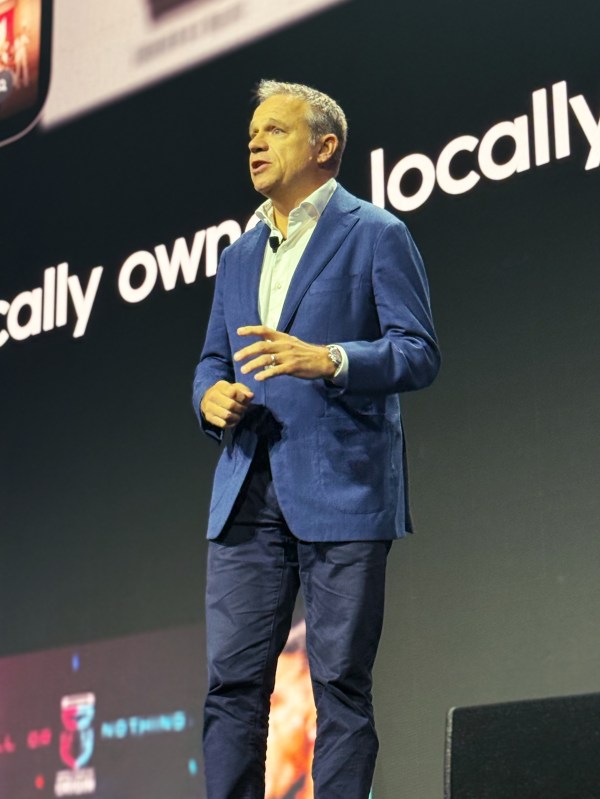
‘As hungry as ever’ but no change in the menu: Nine upfront

Matt James gets serious on the Carriageworks stage, Sydney
Australians love sports, news, reality TV, and seamless brand integrations — and Nine has got them all, and then some. That was the overriding message at the media company’s warm and friendly 2026 Upfront, held at Carriageworks in Sydney on Wednesday afternoon.
There was no cavalcade of screen celebrities pitching from the stage, no major innovations to launch into the market. Just continual reassurance that if you’re an advertiser looking to reach Australians, then Nine provides a one-stop shop for all your advertising needs — so don’t bother flinging money into the great wide maw of the digital platforms. The internet is an unchecked wasteland of flashing banner ads, risky influencers, and fickle memes. Nine is solid as an oak news-desk, safe as the houses on the Block cul-de-sac, as current as today’s copy of The Age. It’s the place where Australians turn for trusted news, the best in entertainment, and heart-racing sport.
Chief sales officer Matt James opened the presentation by reminding everyone just how old Nine’s properties are. Next year, 2GB turns 100, and Nine will have been on air for 70 years. The Sydney Morning Herald will have been in print for 195 years, while The Age was founded 170 years ago. Richard Wilkins is getting up there too (Fun fact: I spotted him getting a loving shoulder massage from Karl Stefanovic as we were leaving the presentation).
Far from being a tired, lumbering old media dinosaur, however, James told us that Nine feels “as young and as hungry as ever”. But Nine is also stitched into the Australian fabric. In fact, according to TV and streaming boss Amanda Laing, “Nine is Australia”.

Amanda Laing reminds advertisers that Nine is still the one
And Nine/Australia has a raft of advertising solutions that will reach most Aussies across radio, podcasts, streaming, news sites, TV and socials. It’s a one-stop shop! Plus, advertising is finally coming to Stan — the only announcement that elicited a cheer from the crowd.
With PoweredTV, advertisers can buy brand-funded programming, and show integrations that run across Nine’s various TV stations, 9Now, and Stan. Advertisers can also book digital ad campaigns that will run across 9Now, Stan Sport, and HBO Max (which Nine sells advertising inventory for) in one ecosystem. 9Amplify takes your existing campaign and chops it up for social media, as well as creating complementary content to sit alongside the main creative, while 9Now Stories offers advertising and integration opportunities in Nine’s new short-form vertical social videos.
And don’t forget Nine’s Ad Manager, which offers low-price ($500 – $4,000) auto-generated TV campaigns for small-to-medium businesses previously priced out of the television advertising market. Nine is Australia.
Nine’s television content strategy for 2026 is definitely “if it ain’t broke…”
Married At First Sight is back, The Block is back, The Floor is back, the Australian Open and the Winter Olympics are both coming back around, and the NRL is still on Nine.
Of the new programs, the smartest play is MAFS After The Dinner Party, which comes onto Stan immediately after the show airs on Nine, and offers what is basically the DVD extras for each episode: extended cuts, interviews, behind-the-scenes bits, and analysis. Considering MAFS is the highest-rating non-news, non-sports show on Australian TV, this alone might be enough to tempt a number of diehards to subscribe to Stan.
Lego Masters has been overhauled into four TV specials, with each episode tied to a kid-friendly universe: DC Comics, Jurassic Park, Lord of the Rings, and Bluey. The irony of Nine being more successful than the ABC at monetising Bluey aside, it should be clear how similar brand-sponsored builds will be able to play into the show’s future from now, without wrecking the show’s concept too much. After all, who doesn’t want to see Brickman building a Volkswagen Tiguan out of 10,000 Lego blocks?
New lifestyle show 1 Euro House will see Shaynna Blaze and Darren Palmer renovate an old dump they bought in a small Italian village for a euro — a natural extension from Blaze’s previous gig on Selling Houses Australia, and a fun concept to boot.

Amanda Laing and Tory Maguire talk about Shark
The biggest gamble in what is an extraordinarily safe 2026 slate is a show simply named “Shark”. The details are as murky, but the topline premise is that six wet-suit clad celebrities will come face-to-face with a shark. How this concept will stretch to an entire season remains unclear. Is there a game element? Are people voted out? How many sharks? Will there be a human sacrifice?
Shark could either be ratings-winning, appointment viewing for millions of Aussies, or a complete fizzer. Let’s hope it’s not Nine’s unwitting 2026 answer to Seven’s 2024 horoscopes horror-show.
The only cast members announced for Shark so far are Olympic Gold medalist Ariarne Titmus, and the country’s highest-paid tradie, Scotty Cam (plus host Paul de Gelder, who has survived an actual shark attack) but Nine executives told journalists at a media briefing on Tuesday that the other four wetsuit wearers were locked in last week — so prepare the popcorn and shark chum, I guess?
Interestingly, Nine sent out a press release this morning announcing they’ve struck a deal with the NHL to air one ice hockey match each Saturday morning during the upcoming season, news that was curiously absent at the upfront.
Nine’s radio and publishing division are also steering the course, with publishing MD Tory Maguire and audio sales boss Brian Gallagher mostly reminding the audience of its four-city dominance across both the AM radio band and the subscription masthead market.
“This is all great”, I hear you typing in the comments section, “but where’s the evidence?” Lucky you asked.
Nikki Rooke, Nine’s director of sales for TV, presented a raft of research from the likes of Mutinex, Gemba, Kantar, and Adgile that furthered Nine’s pitch nicely.
The biggest claim was that Australian brands are collectively leaving $4 billion in revenue on the table by “under-investing in high-quality, long-form video content”.
Among the other claims: brands that don’t include TV in their media mix miss an average of 39% of “total brand impact”; TV ads deliver 1.4 times more awareness than online video ads; the traditional 30-second ad drives 47% of all sales revenue generated by video; and 22% of all media-generated sales revenue comes from TV, which is second to only search traffic, Rooke pointed out — although she deftly sidestepped the fact that print media, in which Nine has a major investment, was a running a long last on the graph presented on screen.

Nine’s Nikki Rooke with the graph that shows TV in second revenue position — and print in last
These types of percentage-based consumer-behavior claims are hard to quantify, especially when terms like “longevity effect” and “total brand impact” are being thrown around, but the point remains a salient one: despite what Youtube wants you to believe, TV advertising still works. Unless you need to go to the bathroom.
While we’re on the subject of Youtube, Rooke also wins for funniest, snarkiest comment of the afternoon, with the eye-rolling, “apparently the most researched advertising unit of all time has suddenly stopped working, just when Youtube launched a brand new ad format – which is, of course, terrible news for all those Super Bowl advertisers who paid $7 million this year.” Bam!
So, that’s Nine’s pitch. But were the advertisers convinced?
Initiative’s chief investment officer Paige Wheaton told Mumbrella she especially enjoyed what she called “the little myth busting section” about 30-second TV ads delivered by Rooke. “It almost felt a little bit remnant of Stepho [former Nine sales head Michael Stephenson] … giving someone a little jab, which was normally Google or Meta.”

Nikki Rooke
She notes Rooke’s own jab was ”obviously a rebuttal” to Youtube’s claim at its own upfront last month that the traditional 30-second TVC was the least effective kind of video advertising.
“For me, they have different roles,” Wheaton said. “I think that [Nine] need to spend less time trying to push that narrative and be really proud of what they are here for. As media buyer, planners — and I can probably speak for strategists too — we recognise the value that they bring, which is different to Youtube.”
Taylor Fielding, CEO at TFM Digital told Mumbrella that he’s “excited to see one of Australia’s largest media ecosystems move closer towards what brands actually want: proof their media investment is driving sales and brand growth.”
Sue Cant, head of investment at This is Flow agrees with Nine that there is still “a significant under-investment” in television advertising in most media marketing mixes. She tells Mumbrella “the work Nine are doing alongside their measurement partners is much needed and I’m excited to now have the proof points to enable robust conversations with clients”. She hopes this data will help her “switch [clients’] mindset to true sales growth and the effect on their bottom line.”
Cant was also impressed with 9Now Stories and its vertical video format for short-form content – “as we know, mobile first vertical formats are a daily habit for all Aussies so being able to tap into this as another channel to drive engagement is a welcome addition,” she explains. Bill Luu, group media lead at Affinity, also likes this, calling it a “smart move”, and telling Mumbrella it gives advertisers “immersive, trusted environments that align perfectly with how people consume content today”.
Likewise, Luu applauds the tinkering Nine has done to its Ad Manager since launching it this year, saying the upgrades to the system make “premium inventory more accessible for SMBs and independent agencies”. However, he also warns: “The real test will be scaling that accessibility for larger brands while maintaining impact and efficiency.”

Matt Stanton spoke last
Andrew Markou, media and investment partner at Avenue C, said Nine will “enter 2026 like an orc ready for battle, a force to be reckoned with”. He celebrated digital commercial director Nick Young’s on-stage confirmation of a single-source, unified solution to de-duplicated audiences across 9Now, Stan and HBO Max, calling it “a true game changer”.
He notes: “No other publisher can offer what Nine does: a truly integrated media ecosystem, tapping into a combination of audio and visual channels, with content and platforms tailored specifically for differing audiences and dedicated markets.”
EssenceMediacom chief investment officer Sarah James was most impressed by PoweredTV and “seeing how [Nine is] really understanding that brand integration works on a big screen — and then backing up that up with a third party measurement”.
“I think that is probably, for me, the biggest takeout … that they’re seeing that’s what works, seeing that’s what creates the stickiness between their partners, and that’s what makes them stay.”
So there you go. Nine made a compelling case for its advertising might, all in under 90 minutes. I thought it breezed by — even if Richard Wilkins and his tired shoulders seemed to disagree.



I second that, Dave!
I’ll stick to YouTube thanks, nothing of interest to me on FTA even in 2026